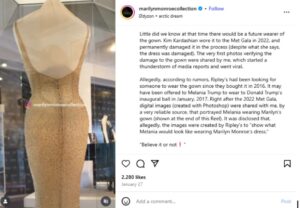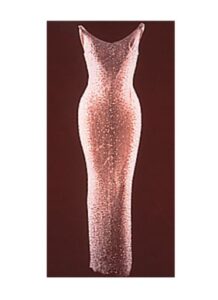
I’ll admit it: I’m a sucker for a good Met Gala moment. The drama, the fashion, the whispers that travel faster than a viral TikTok trend.
But when Kim Kardashian walked down the Met Gala red carpet in Marilyn Monroe’s iconic “Happy Birthday, Mr. President” dress in 2022, I couldn’t help but feel a mixture of awe and unease.
Was this a powerful tribute to a legend, or a dangerous misstep in the name of fashion history?
If you’re anything like me, you’re probably wondering: why did they let Kim Kardashian wear Marilyn Monroe’s dress? And did it really live up to the hype?
Why Did They Let Kim Kardashian Wear Marilyn Monroe’s Dress?
The big question everyone was asking: why was Kim Kardashian allowed to wear that dress?
It’s no secret that Marilyn Monroe’s “Happy Birthday” dress is one of the most famous pieces of fashion history.
The gown, originally designed by Jean Louis and adorned with 2,500 hand-stitched rhinestones, was worn by Monroe in 1962 when she serenaded President John F. Kennedy.
So, how did this Kardashian-Kennedy moment come to be?
Kim’s love for vintage fashion is well-known, but this was no ordinary gown—it was a treasure.
The dress was kept in pristine condition for decades, locked away in the collection of Ripley’s Believe It or Not! after they bought it in 2016 for a whopping $4.8 million.
The iconic nature of the dress made it an obvious choice for a major fashion statement at the Met Gala, but many questioned the decision to let anyone wear it, let alone someone as influential as Kim.
After all, Kim is known for pushing boundaries, but was this boundary-pushing move crossing a line?
Some argue that Kim’s status as a global icon made her the ideal candidate to honor Marilyn’s legacy, while others felt that the dress should remain as a symbol of history, not a spectacle.
Regardless of where you stand, one thing’s for sure—Kim’s decision brought a storm of media buzz that only heightened the stakes for the dress’s future.
How Much Did Kim Kardashian Pay for Marilyn Monroe’s Dress?

Image source – Instagram.com
For many, this question is as intriguing as the dress itself. The price tag for the dress was already eye-watering, but what did it cost Kim Kardashian to wear it?
Technically, Kim didn’t buy the dress—Ripley’s did. In fact, she didn’t even own the piece for the night; she borrowed it under strict conditions.
The high-profile garment was loaned to Kim by Ripley’s Believe It or Not!, which had purchased it in 2016.
Ripley’s, however, did not disclose how much Kim Kardashian paid for the privilege of wearing the dress.
We can only imagine that the figure was substantial, but considering her long history of partnerships with luxury brands and the Met Gala’s immense publicity potential, it was likely worth the investment.
While the true cost of Kim’s Met Gala moment may never be known, it’s clear that the dress was a major part of a broader strategy to position her as a cultural force, a living, breathing fashion statement.
Kim has often used fashion as a tool for self-expression and, in this case, perhaps as a way to draw attention to herself and further her status as a media mogul.
How Much Weight Did Kim Kardashian Lose to Wear Marilyn’s Dress?

Image source- Los Angeles Times
If you’ve been following Kim Kardashian for any length of time, you probably know that she’s no stranger to extreme dieting.
But in order to fit into Monroe’s iconic dress, Kim went to great lengths to lose weight in a short time.
In the lead-up to the Met Gala, Kardashian revealed that she had to lose 16 pounds to fit into the dress.
She followed a strict regimen of low-carb, high-protein foods, along with intense exercise to shed the weight quickly.
While Kim’s transformation was impressive, it also sparked discussions about body image, diet culture, and the pressure to conform to unrealistic beauty standards.
Kim’s drastic weight loss drew mixed reactions from the public. Some applauded her dedication, while others expressed concern over the extreme nature of the diet.
As much as we admire Kim for her discipline, it’s hard to ignore the potential harm in promoting such drastic weight loss methods.
The conversation that followed, however, was an important one about the way we view and talk about bodies in the public eye.
Is the Marilyn Monroe Dress Damaged?

Image source – Instagram.com
Ah, the burning question. Was Marilyn Monroe’s iconic dress actually damaged by Kim Kardashian’s brief wearing of it?
It’s a conversation that has sparked intense debate, especially among textile conservationists and fashion enthusiasts.
The dress, while dazzling in its rhinestone-covered glory, is incredibly fragile. So fragile, in fact, that experts warned against letting anyone wear it at all, let alone parade it down a Met Gala red carpet.
After all, the dress had already endured decades of wear and tear, and exposing it to the rigors of a public event could cause irreparable damage.
Unfortunately, those fears seemed to come to fruition. After Kim wore the dress, images surfaced showing that the fabric had been stretched, some of the rhinestones had fallen off, and the delicate stitching appeared to have been compromised.
Ripley’s responded by stating that the dress was carefully protected during the event and that it was quickly changed out for a replica before any harm could be done.
But that didn’t stop the outrage from fashion purists and preservationists, who argued that no amount of protection could prevent the wear and tear from the sheer act of wearing such a delicate piece of history.
While the dress may not have been irrevocably damaged (thanks to careful precautions), the controversy surrounding the event did bring attention to the complex relationship between fashion, preservation, and celebrity culture.
How to Handle Historic Fashion Pieces Like a Pro

Image source – wikipedia.org
We’ve talked about Kim Kardashian’s journey into Marilyn Monroe’s fashion archives, but what can we learn from it?
If you’re a collector, designer, or just someone with an appreciation for fashion history, here are a few tips on how to handle priceless garments with care:
- Preservation First: Always prioritize the preservation of historical garments. It’s crucial to consult experts before displaying, let alone wearing, delicate pieces.
- Replicas are Key: Whenever possible, opt for high-quality replicas for events like the Met Gala. Fashion can be impactful without risking irreplaceable items.
- Public Awareness: If you’re in the public eye, use your platform responsibly. Fashion statements can be bold, but they should also respect the cultural significance of what’s being worn.
Also read: Jesseca Dupart Net Worth
FAQs About Kim Kardashian’s Marilyn Monroe Dress
Q: How long did Kim Kardashian wear Marilyn Monroe’s dress?
Kim wore the dress for her red carpet appearance at the Met Gala, which was a short period of time, just long enough for photos before she changed into a replica to avoid any damage.
Q: Did Kim Kardashian return Marilyn Monroe’s dress after the event?
Yes, Kim returned the original dress to Ripley’s after the event. It was kept safely in their possession, but the dress was carefully monitored during and after the event.
Q: What other fashion icons has Kim Kardashian been known to channel?
Kim is known for channeling a variety of fashion icons, including Elizabeth Taylor, Sophia Loren, and even the late Princess Diana. She has consistently used fashion to craft her narrative and connect with pop culture.
Final Scoop Before You Jump In
At the end of the day, Kim Kardashian’s Marilyn Monroe dress moment was a perfect storm of celebrity culture, fashion history, and social media buzz.
Was it worth it? Well, that depends on who you ask. What’s certain, though, is that it sparked an important conversation about the fragility of fashion history, the ethics of borrowing iconic pieces, and the ways in which we celebrate cultural heritage.
As we continue to navigate the intersection of fashion, fame, and preservation, I can’t help but think that perhaps we should all take a moment to reflect on the delicate balance between honoring the past and making bold statements in the present.



